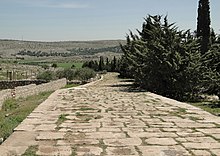Qinnasrin
(Redirected from
Chalcis ad Belum
)قنسرين | |
 | |
| Location | Syria |
|---|---|
| Region | Aleppo Governorate |
| Coordinates | 35°59′15″N 37°2′34″E / 35.98750°N 37.04278°E |
Qinnašrīn (
Latin: Chalcis ad Belum;[3] Greek: Χαλκὶς, translit. Khalkìs), was a historical town in northern Syria. The town was situated 25 km (16 mi) southwest of Aleppo on the west bank of the Queiq (historically, the Belus) and was connected to Aleppo
with a major road during Roman times.
Some scholars propose that the ruins of Qinnašrīn are located at
Al-Iss, Aleppo Governorate to the west of the river.[4] Others think that Qinnasrin has always been located at al-Iss from the Hellenistic to the Ayyubid period.[5]
History
Hellenistic and Roman periods
Roman road connecting between Antioch
and Qinnasrin, then called ChalcisAccording to
Baʿal.[7] In 92 AD, Chalcis received the title "Flavia", in honor of Emperor Domitian, to be known as "Flavia of the Chalcidonese".[8]
Late Roman and Byzantine period
The city was a Christian
Chosroes I.[10]
In
Khosrau I appeared before the city and extracted 200 pounds of gold as ransom in return for sparing the city. This prompted the Emperor Justinian I to order its fortifications rebuilt, a work undertaken by Isidore the Younger (a nephew of Isidore of Miletus) in c. 550.[11]
The Sassanids occupied the city in 608/9, during the
Byzantine–Sassanid War of 602–628, and kept it until the war's end.[11]
Early Islamic period
Barely ten years later, in 636/7, it
conquered by the Arabs after a brief resistance.[11] The Arab general Khalid ibn al-Walid took up residence in the city thereafter.[12] The Umayyad caliph Yazid I (r. 680–683) ordered its walls to be demolished.[13] He or his father and predecessor Mu'awiya I (r. 661–680) made Qinnasrin the center of its own jund (military district), called Jund Qinnasrin, within the greater administrative region of Islamic Syria.[14] They utilized the city as an important army headquarters, though until the mid-10th century there were no recorded events of significance relating to Qinnasrin.[13]
By 943, during
Ikhshidids of Egypt in 945. During the second half of the 10th century, the city became a frequent conflict zone between the Byzantines and Hamdanids during the latter stages of the Arab–Byzantine wars.[13] Upon news of an impending Byzantine assault, the inhabitants evacuated in 963 though they returned afterward.[13] Three years later, Sayf al-Dawla made a stand against the Byzantine emperor Nikephoros II Phokas at Qinnasrin, but ultimately retreated and evacuated its residents, after which the Byzantines set fire to its mosques.[13] The inhabitants then made their abode partly in areas east of the Euphrates and partly in Aleppo.[13] Within several years, Qinnasrin was repopulated but destroyed again by the Byzantines in 998.[13] It was rebuilt, but once more sacked by the Byzantines in 1030.[13]
The Persian geographer
Harim.[13]
Ottoman period
The region was known as Eski Haleb, 'Old Aleppo' during the Ottoman era.[8]
See also
- Balai of Qenneshrin
- Jund Qinnasrin
- Seleucia near Belus, a Syrian town on a different River Belus
- Iamblichus, Neoplatonist philosopher and theurgist
Notes
References
Citations
- ^ "Qenneshrin". www.syriaca.org.
- ^ "قنشرين (ܩܢܫܪ̈ܝܢ) كلمة سريانية تعني عش النسور". Archived from the original on 2017-09-07. Retrieved 2017-02-27.
- ^ Pliny, Nat. Hist., Bk. 5, §81.
- ^ "The Hadir Qinnasrin Project". The University of Chicago.
- ^ "Al-Hadir. Étude archéologique d'un hameau de Qinnasrin (Syrie du Nord, VIIe-XIIe siècles)". 2012.
- ^ Corpus Inscriptionum Iudaeae/Palaestinae: Volume 1, Part 1, p. 449
- ^ a b Cohen (2006), p. 145.
- ^ a b c Phenix (2008), p. 52–53.
- ^ "Echos d'orient". Paris. March 9, 1897 – via Internet Archive.
- ^ Michel Lequien, Oriens christianus in quatuor Patriarchatus digestus, Paris 1740, Vol. II, coll. 785-788
- ^ ISBN 978-0-19-504652-6.
- ^ Kennedy 2007, p. 207.
- ^ a b c d e f g h i j k l m Elisséeff 1986, p. 124.
- ^ Elisséeff 1986, p. 125.
Bibliography
- Cohen, Getzel M. (2006), Hellenistic Settlements in Syria, the Red Sea Basin, and North Africa, Hellenistic Culture and Society, Vol. 46, Los Angeles: University of California Press, ISBN 9780520931022.
- Elisséeff, Nikita (1986). "Kinnasrīn". In ISBN 978-90-04-07819-2.
- ISBN 978-0-306-81740-3.
- Phenix, Robert R. (2008). The sermons on Joseph of Balai of Qenneshrin: rhetoric and interpretation in fifth-century Syriac literature. Mohr Siebeck. pp. 52–54. ISBN 978-3-16-149676-9.
External links
Wikimedia Commons has media related to Chalcis (Syria).
- Excavations at Hadir Qinnasrin, Oriental Institute
- De Chalcis à Qinnasrin

